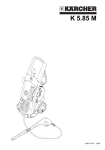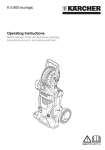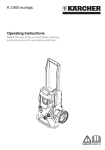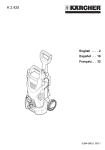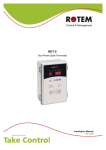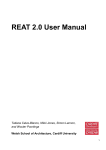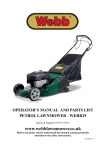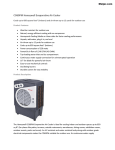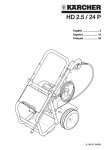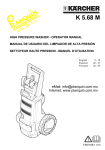Download Pressure washers – Tools - Tooled
Transcript
Pressure washers Pressure washers are a modern day must-have making arduous cleaning tasks a thing of the past. Everything from patios to cars, garden tools to stone walls, windows to doors, pressure washers really make a difference. They will even prepare surfaces/fences for painting or varnishing. Furthermore, they use up to 80 % less water in comparison to using a garden hose. Things to think about before you decide on your pressure washer The main considerations in choosing a pressure washer will be how much time you want to save and what cleaning tasks you have in mind: Performance • • • Higher bar rated products with higher flow rates will clean much faster. Flow rate is the most important factor for effective cleaning. Using accessories and detergents suited to your cleaning task will significantly enhance the cleaning performance, increase time saving and reduce water and energy consumption. Water-cooled induction motors are the latest and most efficient power units using less energy whilst delivering enhanced performance and longer life. Mobility • • • Consider how compact and mobile you need your pressure washer to be and look for a pressure washer with wheels for ease of use. Plug and Clean detergent systems or in-built detergent tanks/ soap dispensers make pressure washers fully mobile and therefore save more time. A longer hose can extend your working radius without moving the machine. Accessories • • • • • • • Patio cleaners (T50, T250,T300 or T400) clean outdoor surfaces, terraces and decking, splash-free and much faster than can be achieved with a lance. The larger the patio cleaner, the faster it does the job. Those with helper handles offer the additional benefit of being able to clean vertical surfaces such as walls, garage doors & fences. Quick Connect/ fit hose systems eliminate kinking thereby reducing set-up time. Vario/pressure-adjustable lances vary the output power of the lance for optimum results on all surfaces from garden furniture to heavy duty brickwork. Dirtblaster/turbo lances concentrate the power for removing stubborn dirt. Foam sprayers coat objects in a luxurious lather for intensive cleaning. Vario joints provide angled reach to clean difficult-to-reach surfaces such as conservatory or caravan roofs. Brushes help with dirt removal. Detergents • • Task specific detergents improve the result - if you are cleaning your car, use a detergent with wax for extra shine. The Plug & Clean detergent system is supplied with 1L of universal detergent and ensures quick and easy detergent changes between applications. Which is the right pressure washer for me? Top of the range pressure washers are more versatile. They have increased power for stubborn dirt but also the ability to reduce the power with the vario lance to clean delicate surfaces. Heavy Duty Application (110-140 bar x high flow rate x vario nozzle) Medium Duty Light Duty (100-110 bar x medium flow rate) (100 bar x low flow rate) Brickwork/stone walls X Concrete driveways X Wooden fences X Guttering X X Boats X X Spa pools and hot tubs X X Cars, motorbikes and bicycles X X X Lawnmowers X X X Patios/decking X X X Garden furniture/tools X X X Rubbish bins X X X Jargon Buster Bar: This is a measure of pressure. Bar - maximum pressure: This is the pressure achieved when the machine is first turned on – it is not possible to maintain this pressure consistently. Bar-rated pressure: This is the operating water pressure of the machine. Motor size: Motor size is measured in watts, and is indicative of how powerful the machine is provided that the product efficiently converts power into cleaning effectiveness. Flow rate: The higher the flow rate (l/hour) the better the performance. Universal Motor: This is an air-cooled, brush type motor that is light enough to allow easy movement whilst still retaining high bar pressure. Induction Motor: This is an air-cooled (unless otherwise stated), piston motor that is more robust and quieter than a universal one which generally delivers higher pressure ratings. Water-cooled Induction Motor: This is the latest in pressure washer technology. Modern-days cars use this method of cooling to optimise engine performance by maintaining consistent operating temperatures. Troubleshooting Guide 1. I don’t appear to have any pressure. A: Check your water supply. All units need a minimum delivery rate of 9 litres a minute. If this is ok then check the nozzle at the end of the lance is not blocked (if it is it can cause back pressure). If there is no blockage there may be an internal leak, or a failed seal or valve so please contact a service agent. 2. The pressure washer seems to be pulsing. A: If the machine is pulsing when you pull the trigger gun check the nozzle at the end of the lance is not blocked. If there is no blockage remove the lance from the trigger gun to eliminate a faulty lance. If the machine is pulsing when you have released the trigger gun then it could be a check valve or there may be a crack in the front part of the pump so please contact a service agent. 3. There is no detergent coming through. A: Firstly check the detergent supply is correctly connected to the machine according to the user manual. To pull detergent through using a vario lance the nozzle needs to be turned to the low pressure setting. If the machine will still not pull detergent through remove the lance from the trigger gun to eliminate a blockage in the lance. If there is still no detergent coming through please contact a service agent as there may be a faulty chemical valve. 4. The pressure washer cuts out after a few minutes of use. A: If you are using an extension lead check that it is 13 amps or higher and that you are using the right size cable. Up to 10 metres the size of the cable needs to be 1.5mm core. From 10 to 20m the cable needs to be 2.5mm core. 5. The trigger won’t lock in the ‘on’ position. A: For safety reasons the button on the trigger gun will only lock in the ‘off’ position. 6. My hose keeps blowing off. A: Pull back the threaded sleeve to expose the nipple and insert firmly into the machine. Then tighten the screw connector making sure it is sealed but not double-threaded.



